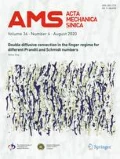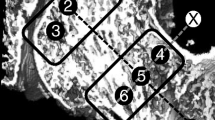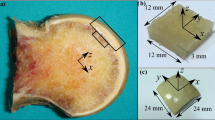Abstract
This study aims to investigate the regional variations of trabecular morphological parameters and mechanical parameters of the femoral head, as well as to determine the relationship between trabecular morphological and mechanical parameters. Seven femoral heads from patients with fractured proximal femur were scanned using a micro-CT system. Each femoral head was divided into 12 sub-regions according to the trabecular orientation. One \(125\,\hbox {mm}^{3}\) trabecular cubic model was reconstructed from each sub-region. A total of 81 trabecular models were reconstructed, except three destroyed sub-regions from two femoral heads during the surgery. Trabecular morphological parameters, i.e. trabecular separation (Tb.Sp), trabecular thickness (Tb.Th), specific bone surface (BS/BV), bone volume fraction (BV/TV), structural model index (SMI), and degree of anisotropy (DA) were measured. Micro-finite element analyses were performed for each cube to obtain the apparent Young’s modulus and tissue level von Mises stress distribution under 1 % compressive strain along three orthogonal directions, respectively. Results revealed significant regional variations in the morphological parameters (\(P < 0.05\)). Young’s moduli along the trabecular orientation were significantly higher than those along the other two directions. In general, trabecular mechanical properties in the medial region were lower than those in the lateral region. Trabecular mechanical parameters along the trabecular orientation were significantly correlated with BS/BV, BV/TV, Tb.Th, and DA. In this study, regional variations of microstructural features and mechanical properties in the femoral head of patients with proximal femur fracture were thoroughly investigated at the tissue level. The results of this study will help to elucidate the mechanism of femoral head fracture for reducing fracture risk and developing treatment strategies for the elderly.
Graphical Abstract
Bone blocks were reconstructed from micro-CT images of proximal femoral fracture patients. Apparent Young’s modulus and average stress of cancellous bone along three orthogonal directions were calculated by FEA. There were significant differences in mechanical properties between different regions and between different directions.





Similar content being viewed by others
References
Cong, A., Buijs, J.O., Dragomir-Daescu, D.: In situ parameter identification of optimal density-elastic modulus relationships in subject-specific finite element models of the proximal femur. Med. Eng. Phys. 33, 164–173 (2011)
Gong, H., Zhang, M., Yeung, H.Y., et al.: Regional variations in microstructural properties of vertebral trabeculae with aging. J. Bone Miner. Metab. 23, 174–180 (2005)
Judex, S., Boyd, S., Qin, Y.X., et al.: Combining high-resolution micro-computed tomography with material composition to define the quality of bone tissue. Curr. Osteoporos. Rep. 1, 11–19 (2003)
Niebur, G.L., Feldstein, M.J., Yuen, J.C., et al.: High-resolution finite element models with tissue strength asymmetry accurately predict failure of trabecular bone. J. Biomech. 33, 1575–1583 (2000)
Verhulp, E., Rietbergen, B., Huiskes, R.: Comparison of micro-level and continuum-level voxel models of the proximal femur. J. Biomech. 39, 2951–2957 (2006)
Baum, T., Carballido-Gamio, J., Huber, M.B., et al.: Automated 3D trabecular bone structure analysis of the proximal femur-prediction of biomechanical strength by CT and DXA. Osteoporos. Int. 21, 1553–1564 (2010)
Delaere, O., Dhem, A., Bourgois, R.: Cancellous bone and mechanical strength of the femoral neck. Arch. Orthop. Trauma Surg. 108, 72–75 (1989)
Lai, Y.M., Qin, L., Yeung, H.Y., et al.: Regional differences in trabecular BMD and micro-architecture of weight-bearing bone under habitual gait loading—a pQCT and microCT study in human cadavers. Bone 37, 274–282 (2005)
Martens, M., Audekercke, R.V., Delport, P., et al.: The mechanical characteristics of cancellous bone at the upper femoral region. J. Biomech. 16, 971–983 (1983)
Werner, C., Iversen, B.F., Therkildsen, M.H.: Contribution of the trabecular component to mechanical strength and bone mineral content of the femoral neck. An experimental study on cadaver bones. Scand. J. Clin. Lab. Invest. 48, 457–460 (1988)
Krischak, G.D., Augat, P., Wachter, N.J., et al.: Predictive value of bone mineral density and Singh Index for the in vitro mechanical properties of cancellous bone in the femoral head. Clin. Biomech. 14, 346–351 (1999)
Brenneman, S.K., Barrett-Connor, E., Sajjan, S., et al.: Impact of recent fracture on health-related quality of life in postmenopausal women. J. Bone Miner. Res. 21, 809–816 (2006)
Gong, H., Zhang, M., Qin, L., et al.: Regional variations in the apparent and tissue-level mechanical parameters of vertebral trabecular bone with aging using micro-finite element analysis. Ann. Biomed. Eng. 35, 1622–1631 (2007)
Nazarian, A., Muller, J., Zurakowski, D., et al.: Densitometric, morphometric and mechanical distributions in the human proximal femur. J. Biomech. 40, 2573–2579 (2007)
Singh, M., Nagrath, A.R., Maini, P.S.: Changes in trabecular pattern of the upper end of the femur as an index of osteoporosis. J. Bone Jt. Surg. (Am) 52, 457–467 (1970)
Ulrich, D., Rietbergen, B., Laib, A., et al.: The ability of three-dimensional structural indices to reflect mechanical aspects of trabecular bone. Bone 25, 55–60 (1999)
Bourne, B.C., Meulen, M.C.: Finite element models predict cancellous apparent modulus when tissue modulus is scaled from specimen CT-attenuation. J. Biomech. 37, 613–621 (2004)
Harrison, N.M., McDonnell, P.F., O’Mahoney, D.C., et al.: Heterogeneous linear elastic trabecular bone modeling using micro-CT attenuation data and experimentally measured heterogeneous tissue properties. J. Biomech. 41, 2589–2596 (2008)
Jaasma, M.J., Bayraktar, H.H., Niebur, G.L., et al.: Biomechanical effects of intraspecimen variations in tissue modulus for trabecular bone. J. Biomech. 35, 237–246 (2002)
Linden, J.C., Birkenhager-Frenkel, D.H., Verhaar, J.A., et al.: Trabecular bone’s mechanical properties are affected by its non-uniform mineral distribution. J. Biomech. 34, 1573–1580 (2001)
Djuric, M., Djonic, D., Milovanovic, P., et al.: Region-specific sex-dependent pattern of age-related changes of proximal femoral cancellous bone and its implications on differential bone fragility. Calcif. Tissue Int. 86, 192–201 (2010)
Ascenzi, M.G., Hetzer, N., Lomovtsev, A., et al.: Variation of trabecular architecture in proximal femur of postmenopausal women. J. Biomech. 44, 248–256 (2011)
Cui, W.Q., Won, Y.Y., Baek, M.H., et al.: Age-and region-dependent changes in three-dimensional microstructural properties of proximal femoral trabeculae. Osteoporos. Int. 19, 1579–1587 (2008)
Tanck, E., Bakker, A.D., Kregting, S., et al.: Predictive value of femoral head heterogeneity for fracture risk. Bone 44, 590–595 (2009)
Yang, L., Burton, A.C., Bradburn, M., et al.: Distribution of bone density in the proximal femur and its association with hip fracture risk in older men: the MrOS study. J. Bone Miner. Res. 27, 2314–2324 (2012)
Keyak, J.H., Rossi, S.A., Jones, K.A., et al.: Prediction of femoral fracture load using automated finite element modeling. J. Biomech. 31, 125–133 (1997)
Morgan, E.F., Bayraktar, H.H., Keaveny, T.M.: Trabecular bone modulus-density relationships depend on anatomic site. J. Biomech. 36, 897–904 (2003)
Snyder, S.M., Schneider, E.: Estimation of mechanical properties of cortical bone by computed tomography. J. Orthop. Res. 9, 422–431 (1991)
Homminga, J., McCreadie, B.R., Ciarelli, T.E., et al.: Cancellous bone mechanical properties from normals and patients with hip fractures differ on the structural level, not on the bone hard tissue level. Bone 30, 759–764 (2002)
Lochmuller, E.M., Matsuura, M., Bauer, J., et al.: Site-specific deterioration of trabecular bone architecture in men and women with advancing age. J. Bone Miner. Res. 23, 1964–1973 (2008)
Mori, S., Harruff, R., Ambrosius, W., et al.: Trabecular bone volume and microdamage accumulation in the femoral heads of women with and without femoral neck fractures. Bone 21, 521–526 (1997)
El-Kaissi, S., Pasco, J.A., Henry, M.J., et al.: Femoral neck geometry and hip fracture risk: The Geelong osteoporosis study. Osteoporos. Int. 16, 1299–1303 (2005)
Gnudi, S., Ripamonti, C., Gualtieri, G., et al.: Geometry of proximal femur in the prediction of hip fracture in osteoporotic women. Br. J. Radiol. 72, 729–733 (1999)
Acknowledgments
This work is supported by the National Natural Science Foundation of China (Nos. 11322223, 11432016, 81471753 and 11272134), and the 973 Program (No. 2012CB821202).
Author information
Authors and Affiliations
Corresponding author
Rights and permissions
About this article
Cite this article
Lü, L., Meng, G., Gong, H. et al. Tissue level microstructure and mechanical properties of the femoral head in the proximal femur of fracture patients. Acta Mech Sin 31, 259–267 (2015). https://doi.org/10.1007/s10409-015-0414-9
Received:
Revised:
Accepted:
Published:
Issue Date:
DOI: https://doi.org/10.1007/s10409-015-0414-9




